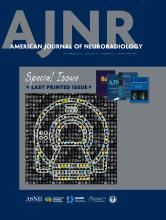Review ArticleNeurodegenerative Disorder Imaging
Atypical Parkinsonian Syndromes: Structural, Functional, and Molecular Imaging Features
Graham Keir, Michelle Roytman, Faizullah Mashriqi, Shaya Shahsavarani and Ana M. Franceschi
American Journal of Neuroradiology December 2024, 45 (12) 1865-1877; DOI: https://doi.org/10.3174/ajnr.A8313
Graham Keir
aFrom the Neuroradiology Division (G.K., M.R.), Department of Radiology, Weill Cornell Medical College, NY-Presbyterian Hospital, New York, New York
Michelle Roytman
aFrom the Neuroradiology Division (G.K., M.R.), Department of Radiology, Weill Cornell Medical College, NY-Presbyterian Hospital, New York, New York
Faizullah Mashriqi
bNeuroradiology Division (F.M., S.S., A.M.F.), Department of Radiology, Donald and Barbara Zucker School of Medicine at Hofstra/Northwell, Lenox Hill Hospital, New York, New York
Shaya Shahsavarani
bNeuroradiology Division (F.M., S.S., A.M.F.), Department of Radiology, Donald and Barbara Zucker School of Medicine at Hofstra/Northwell, Lenox Hill Hospital, New York, New York
Ana M. Franceschi
bNeuroradiology Division (F.M., S.S., A.M.F.), Department of Radiology, Donald and Barbara Zucker School of Medicine at Hofstra/Northwell, Lenox Hill Hospital, New York, New York

References
- 1.↵
- Goldman JG,
- Goetz CG,
- Brandabur M, et al
- 2.↵
- 3.↵
- Dugger BN,
- Dickson DW
- 4.↵
- Irwin DJ,
- Hurtig HI
- 5.↵
- 6.↵
- 7.↵
- 8.↵
- Oppedal K,
- Ferreira D,
- Cavallin L, et al
- 9.↵
- Nakatsuka T,
- Imabayashi E,
- Matsuda H, et al
- 10.↵
- 11.↵
- Watson R,
- Blamire AM,
- Colloby SJ, et al
- 12.↵
- 13.↵
- Whitwell JL,
- Graff-Radford J,
- Singh TD, et al
- 14.↵
- 15.↵
- 16.↵
- Rowe CC,
- Villemagne VL
- 17.↵
- Kantarci K,
- Lowe VJ,
- Chen Q, et al
- 18.↵
- 19.↵
- 20.↵
- Khamis K,
- Giladi N,
- Levine C, et al
- 21.↵
- Walker Z,
- Costa DC,
- Janssen AG, et al
- 22.↵
- 23.↵
- 24.↵
- Hauw JJ,
- Daniel SE,
- Dickson D, et al
- 25.↵
- Kataoka H,
- Tonomura Y,
- Taoka T, et al
- 26.↵
- Paviour DC,
- Price SL,
- Stevens JM, et al
- 27.↵
- Righini A,
- Antonini A,
- De Notaris R, et al
- 28.↵
- 29.↵
- 30.↵
- 31.↵
- 32.↵
- 33.↵
- 34.↵
- Eckert T,
- Barnes A,
- Dhawan V, et al
- 35.↵
- 36.↵
- 37.↵
- 38.↵
- 39.↵
- 40.↵
- Lee WH,
- Lee CC,
- Shyu WC, et al
- 41.↵
- Franceschi AM,
- Franceschi D
- Zamora C,
- Muhleman M,
- Castillo M
- 42.↵
- Aquino D,
- Bizzi A,
- Grisoli M, et al
- 43.↵
- 44.↵
- 45.↵
- 46.↵
- 47.↵
- Bhattacharya K,
- Saadia D,
- Eisenkraft B, et al
- 48.↵
- Cicilet S,
- Furruqh F,
- Biswas A, et al
- 49.↵
- Chandran V,
- Stoessl AJ
- 50.↵
- 51.↵
- Shiga K,
- Yamada K,
- Yoshikawa K, et al
- 52.↵
- 53.↵
- 54.↵
- Zheng W,
- Ren S,
- Zhang H, et al
- 55.↵
- Meyer PT,
- Frings L,
- Rücker G, et al
- 56.↵
- Hong C-M,
- Ryu H-S,
- Ahn B-C
- 57.↵
- 58.↵
- Van Laere K,
- Clerinx K,
- D’Hondt E, et al
- 59.↵
- 60.↵
- Franceschi AM,
- Franceschi D
- Niethammer M
- 61.↵
- Mahapatra RK,
- Edwards MJ,
- Schott JM, et al
- 62.↵
- 63.↵
- Armstrong MJ,
- Litvan I,
- Lang AE, et al
- 64.↵
- 65.↵
- Abe K,
- Terakawa H,
- Takanashi M, et al
- 66.↵
- 67.↵
- 68.↵
- Blin J,
- Vidailhet M,
- Pillon B, et al
- 69.↵
- Pardini M,
- Huey ED,
- Spina S, et al
- 70.↵
- Cho H,
- Baek MS,
- Choi JY, et al
- 71.↵
- Pirker W,
- Djamshidian S,
- Asenbaum S, et al
- 72.↵
- Kikuchi A,
- Okamura N,
- Hasegawa T, et al
- 73.↵
- 74.↵
- Tezuka T,
- Takahata K,
- Seki M, et al
- 75.↵
- Wardlaw JM,
- Smith EE,
- Biessels GJ, et al
- 76.↵
- 77.↵
- 78.↵
- Antonini A,
- Vitale C,
- Barone P, et al
- 79.↵
- Rissardo JP,
- Caprara ALF
- 80.↵
- 81.↵
- Laruelle M,
- Abi-Dargham A,
- van Dyck CH, et al
- 82.↵
- Burn DJ,
- Brooks DJ
In this issue
American Journal of Neuroradiology
Vol. 45, Issue 12
1 Dec 2024
Advertisement
Graham Keir, Michelle Roytman, Faizullah Mashriqi, Shaya Shahsavarani, Ana M. Franceschi
Atypical Parkinsonian Syndromes: Structural, Functional, and Molecular Imaging Features
American Journal of Neuroradiology Dec 2024, 45 (12) 1865-1877; DOI: 10.3174/ajnr.A8313
0 Responses
Jump to section
Related Articles
- No related articles found.
Cited By...
- No citing articles found.
This article has been cited by the following articles in journals that are participating in Crossref Cited-by Linking.
- Kurt A. JellingerJournal of Neural Transmission 2025 132 4
- Rong Zeng, Juyan Guo, Garrett Bullock, Gary S. Johnson, Martin L. KatzGenes 2024 15 11
- Ankica Grujevska, Daniela Ristikj-Stomnaroska, Anastasija AngelovskaOpen Access Macedonian Journal of Medical Sciences 2025 13 1
- Kurt A. JellingerDiseases 2025 13 2
More in this TOC Section
Similar Articles
Advertisement











